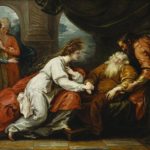Published December 30, 2015
Most visitors to the Isabella Stewart Gardner Museum’s “Ornament & Illusion: Carlo Crivelli of Venice” won’t know the work of this masterly Renaissance painter.
Blame that on that great tastemaker, the painter and architect Giorgio Vasari, author of “The Lives of the Most Excellent Painters, Sculptors, and Architects” (1550). This immensely influential book invented a Florentine-centric history of Renaissance art that we still follow, as anyone who has endured the crush of sweating tourists in the Uffizi or the Sistine Chapel knows well.
But visit a so-called provincial museum elsewhere in Italy and you’ll probably have the place to yourself. Following this road less taken is rewarding, for it leads to a host of superb, but still neglected Renaissance painters, sculptors and architects who Vasari missed: Carlo Crivelli (c. 1430-1495) is one of these.
“Ornament & Illusion,” curated by Stephen J. Campbell and Oliver Tostmann and comprising 22 paintings and one drawing, is to be applauded for several reasons. It is the first American exhibition devoted to Crivelli, and though many of its paintings are fragments of altarpieces barbarously dismembered by dealers to sell as individual pieces, it will serve as a welcome, if limited, introduction to his art.
It is also a fitting exhibition for the Gardner. In 1897, its formidable namesake bought Crivelli’s “Saint George Slaying the Dragon” (1470) on the advice of the budding connoisseur Bernard Berenson. “You,” he told her, “never in your life have seen anything so beautiful . . . and in line it is drawn as if by lightning.” As a visit to this exhibition proves, Berenson’s words were no mere sales pitch.
A Venetian, Crivelli’s earliest training seems to have been with his father and brother. We know from an altarpiece dated 1468 that he had moved south and was working in the Marche, a mountainous region in east central Italy.
In 1486, he signed the large “The Annunciation, With Saint Emidius” (National Gallery, London), the highlight of the exhibition. The picture has all the traditional elements of the Annunciation story (Gabriel, the kneeling Madonna, the descent of the Holy Spirit into the Virgin’s room), but Crivelli has weirdly supercharged the scene. The Virgin’s house, the adjacent buildings, and the pavement are steeply foreshortened, creating a vertiginous rush into space. This is opposed by an obsessive plethora of decorative detail (carved lintels, pilasters and other architectural details, oriental carpets, flower pots, birds), which acts as a visual brake, halting the eye from its backward flight.
Such an abundance of decoration and ornament is a hallmark of Crivelli’s eccentric style. The Gardner’s “Saint George Slaying the Dragon,” part of a dismembered altarpiece (partially reconstructed in the exhibition), is a skillfully painted fairy-tale version of the grisly event. St. George’s horse rears in fright from the very toy-like dragon, already run through by the saint’s red-and-white, candy-cane-striped lance. Although the space, halted by the shimmering gold-leaf background, is much flatter than the Annunciation’s, the surface still teems with decorative details, particularly the horse’s trappings carved into layers of gesso built on the picture’s surface.
The artist’s patrons clearly valued the painting’s old-fashioned flat spatial construction and gold background over the newer and more realistic one-point perspective then in favor in Florence and Venice. And while painters in those cities were increasingly using oil paint to achieve credible effects of depth and texture, Crivelli mainly painted his altarpieces in tempera on gesso, a traditional medium that promotes detail and line—another sign that his customers were conservative in their tastes. They viewed these paintings not as art in our sense, but as potent, supernatural religious icons.
Nowhere is this better seen than in “The Dead Christ With the Virgin, St. John, and St. Mary Magdalene” (Museum of Fine Arts, Boston) signed and dated by Crivelli in 1485. There are echoes of the Venetian Giovanni Bellini here, but that artist’s measured, quietly sorrowful interpretation is absent from Crivelli’s depiction. Against a beautifully tooled gold background, the three saints support Christ’s lifeless gray corpse. The Magdalene, holding his legs, looks imploringly toward his face, while the anguished Virgin, her mouth twisted in pain, touches the awful gash in his side. John screams in agony, his hand intertwined with Christ’s now twisted skeletal claw. The raw emotional charge of this painting is extraordinary, unforgettable, and a landmark of Renaissance art.
An illustrated catalog with essays, including an unintentionally hilarious one titled “Carlo Crivelli: Portrait of the Artist as a Cucumber,” accompanies the exhibition. Written in the jargon of today’s academic art history, the publication will be of interest mainly to art historians, while much of it will be helpful to those learning how not to write about art. A brochure with essential information about the artist and his times would have been more helpful for the many visitors seeing Crivelli’s work for the first time.
Nevertheless, they will leave having seen the work of a remarkable artist who, as the Gardner exhibition proves, deserves a more prominent place in the history of Renaissance painting.
Mr. Cole, a former chairman of the NEH, is a senior fellow at the Ethics and Public Policy Center.










